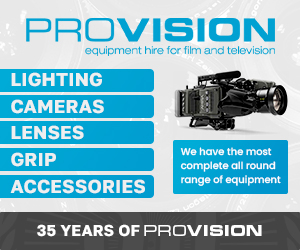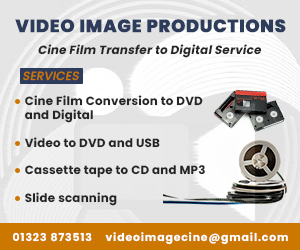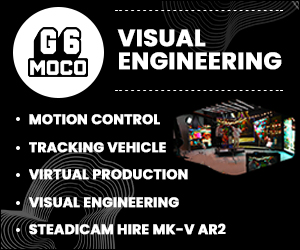Broadcast News
01/05/2018
Slow Motion - What You Really Need To Know

It's part of the job description of every natural history filmmaker to travel, often overseas, typically to remote locations or extreme environments - or both – and without the luxury of a porter to lug the gear for them.
Any innovation that can reduce the payload, improve versatility and still deliver the unique perspective on a subject is game for wildlife cinematographers and Mark Payne-Gill is no exception.
A highly skilled lighting documentary, wildlife cameraman and naturalist, Mark Payne-Gill is renowned for excelling in long lens, high speed and macro cinematography along with more specialised experience with time-lapse, motion control and low light night filming. With over thirty years field craft experience, his credits include BBC Natural History Unit's critically acclaimed 'Blue Planet 2', 'Planet Earth 2' and 'Planet Earth' series and Offspring Films' 'Big Cats: Amazing Animal Family' for which he was BAFTA nominated for best cinematography in 2016.
"A lot of what I do is needing to be reactive and to just grab a camera and run with it," he says. "Anything that gives me more freedom to work in those situations in a way that is more efficient and more productive is attractive to me."
The Phantom Flex 4K broke ground with its ability to record high speed action at 1000 frames a second in 4K. Payne-Gill had used it extensively including in the Namibian desert to capture the behaviour of insects and small reptiles. Yet its 6.3kg weight and bulk meant it was not designed with the needs of the wildlife photographer in mind.
"Just carrying the Flex for 50 yards to another position to catch different light is more of an effort than it should be which is why I was excited to try the compact Phantom VEO 4K," says Payne-Gill.
The VEO 4K builds on the Phantom's imaging legacy with identical sensor technology but in a package which provides exceptional economy of movement and of budget.
Payne-Gill took one of the first models in the UK, at VMI, out to a meadow and woodland area owned by bird specialists and handlers Lloyd & Rose Buck near Bristol to test record owls in flight.
"The first thing that struck me was just how compact the camera is," he reports. "Fully stripped-down, the body weight is just 2.5kg and that means you can carry this in a single Peli. A Flex plus accessories means you are having to pack three cases so there's an immediate cost saving there and less hassle for the team in terms of lugging boxes around.
He continues: "Whereas the Flex needs a power hungry 120-150W and several big block batteries requiring separate Peli cases, the VEO 4K only draws 80W and the power lasted really well on a normal V-Lock. That on its own is a game-changer for streamlining your travel kit. Smaller, in this case, gives you more."
Even better than this are the new compact Hawkwoods Mini V-Lock batteries which are ideally suited to working with the Phantom VEO 4K camera.
Like the Flex4K, the camera hardware includes a global shutter and optical low pass filter. The camera can be placed in a hide or on a jib/crane and remotely controlled via an optional wireless control unit (including control of the capture process and allowing playback mode of all controls, save and transfer commands too).
"Although the master controls of the camera were, for me, sited in an awkward place, the main menu system itself felt very easy to navigate and certainly no issue for anyone familiar with Phantom operation."
The beauty of the VEO's size is a big bonus for any camera-operator, enabling them to hand hold or shoulder mount it for longer.
"When you're shooting very short clips of two seconds duration then stabilization is not necessarily an issue but the VEO's lighter weight also means that you can mount the camera on a gimbal, crane, jib or on board a heavier-duty drone without issue."
The workflow with the VEO 4K is just the same as with its bigger brother. You can record continually onto its onboard RAM and halt the recording function by activating a trigger to ensure that you never miss an event. However, the main selling point of the Flex - its superfast download of media to CineMags which can be accomplished in seconds - could be the Achilles heel of the VEO4K.
"The VEO4K boasts a sizeable 72GB internal storage but offload is to C-Fast 2.0 cards, a workflow that is undoubtedly slower," says Payne-Gill. "In continual shoot mode you would press the button to halt recording so that all 72GB is filled. After this, set to replay mode, then scrub to locate start and end points, assign handlebars, then delete all unwanted material."
He calculates that a 10 second clips at 1000fps with Flex would take about 40 seconds to download "but often you are trimming it to maybe a third of that and you can be done in 15 seconds". By contrast, 5.6 seconds of 1000fps capture on the VEO4K will play out for almost 4 minutes when played at 25 fps: "That's when your workflow in the field starts to slow up - if you are saving a lot of clips."
Payne Gill explains that when he works he is always keen to trim the clip as quickly as possible in the camera, making sure to discard the media that he doesn't need, "and ensuring that the ones I do save are as small as possible to maintain an efficient workflow".
"In addition, you can use the partitioning function where you can select from two shots out of the RAM and if you don't like the first take you can go for the second one. This will improve your efficiency. It all comes down to managing your technique in the field. If you understand and work with the camera's limitations you can work extremely well without too much, if any, of a compromise at all.
"The whole thing about the VEO4K is that it is a lot cheaper than the Flex but that does come with a catch. On the one hand you don't need to carry big CineMags – which also come at a cost – but the C-Fast write speed is comparatively slow. You've got to weigh up all the variables as you would with any tool.
"For instance, the VEO 4K can be supplied with your choice of either PL or EF mount, to enable a wide range of industry standard lenses without limiting your choice to the most expensive film primes.
"The VEO4K will certainly allow a producer achieve superb high-speed images in 4K at a price that they previously might not have been able to afford."
Author: VMI
vmi.tv
Any innovation that can reduce the payload, improve versatility and still deliver the unique perspective on a subject is game for wildlife cinematographers and Mark Payne-Gill is no exception.
A highly skilled lighting documentary, wildlife cameraman and naturalist, Mark Payne-Gill is renowned for excelling in long lens, high speed and macro cinematography along with more specialised experience with time-lapse, motion control and low light night filming. With over thirty years field craft experience, his credits include BBC Natural History Unit's critically acclaimed 'Blue Planet 2', 'Planet Earth 2' and 'Planet Earth' series and Offspring Films' 'Big Cats: Amazing Animal Family' for which he was BAFTA nominated for best cinematography in 2016.
"A lot of what I do is needing to be reactive and to just grab a camera and run with it," he says. "Anything that gives me more freedom to work in those situations in a way that is more efficient and more productive is attractive to me."
The Phantom Flex 4K broke ground with its ability to record high speed action at 1000 frames a second in 4K. Payne-Gill had used it extensively including in the Namibian desert to capture the behaviour of insects and small reptiles. Yet its 6.3kg weight and bulk meant it was not designed with the needs of the wildlife photographer in mind.
"Just carrying the Flex for 50 yards to another position to catch different light is more of an effort than it should be which is why I was excited to try the compact Phantom VEO 4K," says Payne-Gill.
The VEO 4K builds on the Phantom's imaging legacy with identical sensor technology but in a package which provides exceptional economy of movement and of budget.
Payne-Gill took one of the first models in the UK, at VMI, out to a meadow and woodland area owned by bird specialists and handlers Lloyd & Rose Buck near Bristol to test record owls in flight.
"The first thing that struck me was just how compact the camera is," he reports. "Fully stripped-down, the body weight is just 2.5kg and that means you can carry this in a single Peli. A Flex plus accessories means you are having to pack three cases so there's an immediate cost saving there and less hassle for the team in terms of lugging boxes around.
He continues: "Whereas the Flex needs a power hungry 120-150W and several big block batteries requiring separate Peli cases, the VEO 4K only draws 80W and the power lasted really well on a normal V-Lock. That on its own is a game-changer for streamlining your travel kit. Smaller, in this case, gives you more."
Even better than this are the new compact Hawkwoods Mini V-Lock batteries which are ideally suited to working with the Phantom VEO 4K camera.
Like the Flex4K, the camera hardware includes a global shutter and optical low pass filter. The camera can be placed in a hide or on a jib/crane and remotely controlled via an optional wireless control unit (including control of the capture process and allowing playback mode of all controls, save and transfer commands too).
"Although the master controls of the camera were, for me, sited in an awkward place, the main menu system itself felt very easy to navigate and certainly no issue for anyone familiar with Phantom operation."
The beauty of the VEO's size is a big bonus for any camera-operator, enabling them to hand hold or shoulder mount it for longer.
"When you're shooting very short clips of two seconds duration then stabilization is not necessarily an issue but the VEO's lighter weight also means that you can mount the camera on a gimbal, crane, jib or on board a heavier-duty drone without issue."
The workflow with the VEO 4K is just the same as with its bigger brother. You can record continually onto its onboard RAM and halt the recording function by activating a trigger to ensure that you never miss an event. However, the main selling point of the Flex - its superfast download of media to CineMags which can be accomplished in seconds - could be the Achilles heel of the VEO4K.
"The VEO4K boasts a sizeable 72GB internal storage but offload is to C-Fast 2.0 cards, a workflow that is undoubtedly slower," says Payne-Gill. "In continual shoot mode you would press the button to halt recording so that all 72GB is filled. After this, set to replay mode, then scrub to locate start and end points, assign handlebars, then delete all unwanted material."
He calculates that a 10 second clips at 1000fps with Flex would take about 40 seconds to download "but often you are trimming it to maybe a third of that and you can be done in 15 seconds". By contrast, 5.6 seconds of 1000fps capture on the VEO4K will play out for almost 4 minutes when played at 25 fps: "That's when your workflow in the field starts to slow up - if you are saving a lot of clips."
Payne Gill explains that when he works he is always keen to trim the clip as quickly as possible in the camera, making sure to discard the media that he doesn't need, "and ensuring that the ones I do save are as small as possible to maintain an efficient workflow".
"In addition, you can use the partitioning function where you can select from two shots out of the RAM and if you don't like the first take you can go for the second one. This will improve your efficiency. It all comes down to managing your technique in the field. If you understand and work with the camera's limitations you can work extremely well without too much, if any, of a compromise at all.
"The whole thing about the VEO4K is that it is a lot cheaper than the Flex but that does come with a catch. On the one hand you don't need to carry big CineMags – which also come at a cost – but the C-Fast write speed is comparatively slow. You've got to weigh up all the variables as you would with any tool.
"For instance, the VEO 4K can be supplied with your choice of either PL or EF mount, to enable a wide range of industry standard lenses without limiting your choice to the most expensive film primes.
"The VEO4K will certainly allow a producer achieve superb high-speed images in 4K at a price that they previously might not have been able to afford."
Author: VMI
vmi.tv
Useful Links
Top Related Stories
Click here for the latest broadcast news stories.
09/06/2014
4K OK? Understanding UltraHD... (Pt 2)
"The latest workstations and professional laptops are now up to the task of 4K content creation and NLE developers are all beginning to support native
4K OK? Understanding UltraHD... (Pt 2)
"The latest workstations and professional laptops are now up to the task of 4K content creation and NLE developers are all beginning to support native
24/04/2014
Sony Adds 4K Live Streaming Support To BRAVIA™ 4K Ultra HD TVs
From August this year, every BRAVIA™ 4K Ultra HD TV owner will be able to enjoy video content streamed with the increasingly popular HEVC (H.265) stan
Sony Adds 4K Live Streaming Support To BRAVIA™ 4K Ultra HD TVs
From August this year, every BRAVIA™ 4K Ultra HD TV owner will be able to enjoy video content streamed with the increasingly popular HEVC (H.265) stan
09/11/2012
4K Or Not 4K – That Is The Question -Part Two
Native 4K Digital Cameras Systems RED RED EPIC and RED SCARLET RED was the initial trailblazer on the march to 4K. Although the RED One was initially
4K Or Not 4K – That Is The Question -Part Two
Native 4K Digital Cameras Systems RED RED EPIC and RED SCARLET RED was the initial trailblazer on the march to 4K. Although the RED One was initially
09/11/2012
4K Or Not 4K – That Is The Question
A producer’s guide to the pros and cons of shooting in 4K What is 4K? Whether a video format is either 'standard' or 'high definition' has always been
4K Or Not 4K – That Is The Question
A producer’s guide to the pros and cons of shooting in 4K What is 4K? Whether a video format is either 'standard' or 'high definition' has always been
09/06/2014
4K OK? Understanding UltraHD... (Pt 1)
In a bid to get his head around the intricacies of 4K format ahead of this summer's landmark broadcasting event, editor Iain Todd spoke to some indust
4K OK? Understanding UltraHD... (Pt 1)
In a bid to get his head around the intricacies of 4K format ahead of this summer's landmark broadcasting event, editor Iain Todd spoke to some indust
04/06/2014
BroadcastAsia2014: 4K To Transform Onscreen Viewing
HD (high definition) viewing will soon be a technology of the past, as a result of the proliferation of 4K coming Asia's way. 4K, also commonly known
BroadcastAsia2014: 4K To Transform Onscreen Viewing
HD (high definition) viewing will soon be a technology of the past, as a result of the proliferation of 4K coming Asia's way. 4K, also commonly known
04/04/2014
Sony And FIFA To Collaborate On A Range Of 4K Initiatives
Sony and FIFA (Fédération Internationale de Football Association) have announced they will collaborate on a range of 4K initiatives at the 2014 FIFA W
Sony And FIFA To Collaborate On A Range Of 4K Initiatives
Sony and FIFA (Fédération Internationale de Football Association) have announced they will collaborate on a range of 4K initiatives at the 2014 FIFA W
17/04/2025
Marshall CV574 Miniature 4K UHD Camera Revolutionises Off-Road Livestreaming
As Director of Media and Aerial Production at Terrible Herbst Motorsports, Bryan Moore is setting new standards in off-road racing media coverage than
Marshall CV574 Miniature 4K UHD Camera Revolutionises Off-Road Livestreaming
As Director of Media and Aerial Production at Terrible Herbst Motorsports, Bryan Moore is setting new standards in off-road racing media coverage than
31/03/2025
Express Media Acquires Ikegami UHK-X700 4K UHD Camera Systems
Express Media has expanded its rental portfolio with the purchase of Ikegami UHK-X700 4K UHD camera systems and BSX-100 25G optical fibre base station
Express Media Acquires Ikegami UHK-X700 4K UHD Camera Systems
Express Media has expanded its rental portfolio with the purchase of Ikegami UHK-X700 4K UHD camera systems and BSX-100 25G optical fibre base station
13/02/2025
Production Crew Acquires 12 Ikegami UHK-X700 UNICAM-XE 4K-UHD Camera Systems
Production Crew, a division of Riyadh-based AFLAM Productions, has invested in 12 Ikegami UHK-X700 UNICAM-XE 4K-UHD camera systems for integration wit
Production Crew Acquires 12 Ikegami UHK-X700 UNICAM-XE 4K-UHD Camera Systems
Production Crew, a division of Riyadh-based AFLAM Productions, has invested in 12 Ikegami UHK-X700 UNICAM-XE 4K-UHD camera systems for integration wit
07/10/2024
Ikegami Unveils New UHL-X40 4K-UHD HDR Camera At NAB New York
Ikegami announces its product lineup for NAB NY 2024. Launching on Ikegami booth 1027 will be the ultra-compact UHL-X40 4K-UHD/HD 3-CMOS camera. Also
Ikegami Unveils New UHL-X40 4K-UHD HDR Camera At NAB New York
Ikegami announces its product lineup for NAB NY 2024. Launching on Ikegami booth 1027 will be the ultra-compact UHL-X40 4K-UHD/HD 3-CMOS camera. Also
11/03/2024
Hitachi Kokusai Now Shipping DK-H700 4K Box Camera
The Hitachi tradition of delivering exceptional visual quality and superior price/performance value for live production applications continues at the
Hitachi Kokusai Now Shipping DK-H700 4K Box Camera
The Hitachi tradition of delivering exceptional visual quality and superior price/performance value for live production applications continues at the
26/09/2023
RE:LIVE Productions Acquires Ikegami UHK-X700 4K-UHD Camera Systems
RE:LIVE Productions, formerly known as Pufferfish Productions, one of Singapore's leading providers of creative video, event management and live strea
RE:LIVE Productions Acquires Ikegami UHK-X700 4K-UHD Camera Systems
RE:LIVE Productions, formerly known as Pufferfish Productions, one of Singapore's leading providers of creative video, event management and live strea
30/08/2023
TNDV Puts New Sony And Panasonic 4K/HD Camera Fleet To Work
TNDV has been putting its new Sony and Panasonic 4K/HD camera fleet to work this summer for high-resolution content acquisition of live and recorded e
TNDV Puts New Sony And Panasonic 4K/HD Camera Fleet To Work
TNDV has been putting its new Sony and Panasonic 4K/HD camera fleet to work this summer for high-resolution content acquisition of live and recorded e
28/06/2022
Ikegami Europe Announces Unicam UHK-X750 4K-UHD HDR Studio Camera
Ikegami Electronics (Europe) has announced a major addition to its range of broadcast production cameras. Introduced at the April 2022 NAB Show in Las
Ikegami Europe Announces Unicam UHK-X750 4K-UHD HDR Studio Camera
Ikegami Electronics (Europe) has announced a major addition to its range of broadcast production cameras. Introduced at the April 2022 NAB Show in Las















